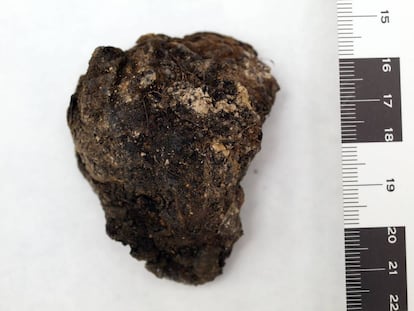A sliver of skull solves seven Civil War crimes
The bone fragment has been identified as belonging to the mother of six children, all of whom were killed at outbreak of conflict

It was past 3pm on a Sunday afternoon in mid-September when forensic scientist Francisco Etxeberria finally emerged from a 50-meter-deep pit in a remote valley in Spain’s northeastern Navarre region to a round of applause, after some six hours underground.
He had been looking for the bones of Juana Josefa Goñi Sagardia, a woman whose body was thrown into the depths of the pit, in Gaztelu-Donamaria, along with six of her children at the onset of the Spanish Civil War (1936-1939). The killers were never apprehended.
Juana Josefa was the relative of a senior army officer, who vowed to find the culprits
In recent weeks, investigators have have found jawbones, femurs, children’s shoes, and a mother of pearl button inside what locals call the Sima de Legarrea, in the Valley of Malerreka.
Everyone had suspected for decades that the bodies were here, even if nobody had spoken up about it. A book entitled La sima (or, The Pit) by Jose Mari Esparza brought the terrible story to light last year. The government of Navarre is funding the excavation work.
The remains of the children of Juana Josefa Goñi Sagardia: Joaquín (16), Antonio (12), Pedro Julián (9), Martina (6), José (3) and Asunción, who was 18-months-old at the time of death, were all down there. Most of the family ended up at the bottom of the pit on August 30, 1936.
Surviving relatives claim they heard four gunshots, but that some members were pushed in alive. Only the father and an older son were saved because they had been conscripted as forced labor at the outbreak of the conflict.

“The jawbones leave no room for doubt,” says Lourdes Herrasti, a bone archeologist who works with Etxeberria at Aranzadi, a scientific research association. The children had been located.
But the mother, who was pregnant at the time, was still missing.
“All we found today is this piece of skull,” said a downcast Etxeberria as he emerged from the pit, covered in mud and still wearing his safety harness. Relatives of the dead fell into a deep silence. They had been expecting something more.
The forensic expert ventured to say that the round bone in his hands was very likely the missing piece of Joaquín’s nearly completely restored skull. But it quickly emerged that the piece did not fit. Yes, it was a piece of skull, but not the eldest child’s. It had to be the mother’s.
Etxeberria’s expression changed. “This has got to be Juana Josefa’s,” he pronounced. Tears welled up in the eyes of Nati, one of the victim’s nieces, now 84 herself. Nati hopes that local authorities will place a symbol in memory of the tragedy at the mouth of the pit, under a great big beech tree.
“They’ve already told us at town hall in Gaztelu that there will be a niche for them at the cemetery. There are people who have apologized to us in the town’s name,” she says. “That was not necessary. We know that the people today have nothing to do with the actions of the people back then.”
Another body
In December of last year, a group of cave explorers that included Francisco Etxeberría went down into the pit. But what they found had nothing to do with the Sagardia family. Instead, what turned up was the body of a 24-year-old who went missing in the area in 2008. The case is under court investigation and no details have yet been released.
A great-grandchild of Juana Josefa’s sister said that other relatives of Civil War victims should also be given a chance to take their loved ones out of their makeshift burials “so their wounds can heal and their anxiety end.”
“But we need help. This [project] was financed by the government of Navarre; the only support we got from the Spanish state was this mailbag, which certainly works great,” added Etxeberria with irony in his voice, showing a large sack used to carry tools in and out of the pit.
The DNA tests have not been completed, but experts at Aranzadi harbor no doubts about the identities behind the bones. The search has ended.
Juana Josefa was an extraordinarily beautiful woman, according to the stories that have been passed down from generation to generation. She was 38 when she and her children were murdered. According to surviving relatives, after falling on hard times, the family had been kicked out of the village accused of petty theft, and had taken refuge in a mountain shack not far from the pit.
Juana Josefa was the relative of a high-ranking army officer who supported General Francisco Franco, and who vowed to find the culprits. The investigation remained open for around 10 years, and the officer even threatened to raze the entire village if nobody spoke up. But the code of silence and fears of reprisals prevented anybody from coming forward. The killers were never found.The bodies were never found either, even though a brief search was carried out in the 1940s.
Finally, the victims will be laid to rest and the local cemetery will include the names of a family that spent the last 80 years buried inside a 50-meter-deep pit.
English version by Susana Urra.
Tu suscripción se está usando en otro dispositivo
¿Quieres añadir otro usuario a tu suscripción?
Si continúas leyendo en este dispositivo, no se podrá leer en el otro.
FlechaTu suscripción se está usando en otro dispositivo y solo puedes acceder a EL PAÍS desde un dispositivo a la vez.
Si quieres compartir tu cuenta, cambia tu suscripción a la modalidad Premium, así podrás añadir otro usuario. Cada uno accederá con su propia cuenta de email, lo que os permitirá personalizar vuestra experiencia en EL PAÍS.
En el caso de no saber quién está usando tu cuenta, te recomendamos cambiar tu contraseña aquí.
Si decides continuar compartiendo tu cuenta, este mensaje se mostrará en tu dispositivo y en el de la otra persona que está usando tu cuenta de forma indefinida, afectando a tu experiencia de lectura. Puedes consultar aquí los términos y condiciones de la suscripción digital.











































